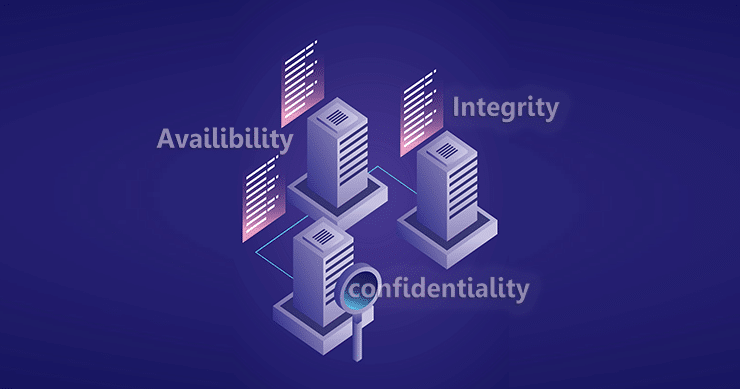To build a robust information security strategy, one must understand and apply the core principles of information security. This blog post will delve into the fundamental principles underpinning effective information security principles and practices.

The Foundation of Information Security
The 3 Principles of Information Security
At its core, information security is guided by three foundational principles, often referred to as the “CIA Triad”:
- Confidentiality: This principle ensures that sensitive information remains confidential and is accessible only to those with the appropriate permissions. In essence, it means that unauthorized individuals or systems should not be able to access protected data.
- Integrity: The integrity principle focuses on the accuracy and reliability of data. It aims to prevent unauthorized changes or alterations to information, ensuring that data remains accurate and trustworthy.
- Availability: Availability emphasizes that information should be accessible and available when needed. This principle ensures that authorized users can access data and resources without disruption.
Let’s explore each of these information security principles in more detail.
Confidentiality: Protecting Data Privacy
Confidentiality is the principle that underlines the importance of keeping sensitive information private and safeguarded from unauthorized access. Maintaining confidentiality involves implementing access controls, encryption, and user authentication mechanisms to restrict access to data based on user roles and permissions.
Key practices for ensuring confidentiality include:
- Access Control: Implementing strict access controls ensures that only authorized users can access sensitive data or systems. Role-based access control (RBAC) and user authentication are common methods to enforce access control.
- Encryption: Encrypting data, both in transit and at rest, is essential for protecting confidentiality. Encryption algorithms scramble data into an unreadable format unless decrypted with the appropriate key.
- Data Classification: Classifying data based on its sensitivity allows organizations to prioritize protection efforts. Highly sensitive data, such as financial records or personal information, should receive the highest level of confidentiality protection.
Integrity: Maintaining Data Accuracy
Integrity is the principle that focuses on preserving the accuracy and reliability of data. Ensuring data integrity means preventing unauthorized changes, alterations, or corruption of information. Data integrity is crucial for maintaining trust in the information you use and share.
Key practices for ensuring integrity include:
- Data Validation: Implementing data validation checks helps identify and prevent unauthorized changes or tampering with data. Validation rules can verify data consistency and integrity.
- Change Control: Establishing change control processes ensures that any modifications to data or systems are documented and authorized. This helps maintain the integrity of information.
- Hashing: Using cryptographic hashing functions, organizations can create unique signatures (hashes) for data. Any changes to the data will result in a different hash value, alerting to potential integrity breaches.
Availability: Ensuring Data Accessibility
Availability is the principle that ensures information and resources are available when needed by authorized users. It guards against disruptions, downtime, or service outages that could prevent users from accessing critical data or systems.
Key practices for ensuring availability include:
- Redundancy: Implementing redundancy in hardware and network infrastructure ensures that if one component fails, another takes over seamlessly, minimizing downtime.
- Disaster Recovery Planning: Developing robust disaster recovery plans helps organizations recover quickly from unexpected events like natural disasters or cyberattacks.
- System Monitoring: Continuous monitoring of systems and networks allows organizations to identify and respond to issues promptly, reducing downtime.
Is The Demise of the CIA Triad Imminent?
The CIA has been the tried and true triad that illustrates the balancing act of the three basic principles of information security for decades. However, our systems are facing challenges in the form of irreversible and destructive attacks on our infrastructure, and the CIA triad is just not standing the test of time. How good can security be when we can assume that there are threat vectors that can breach the most protected systems?
In light of these criticisms, it’s essential to acknowledge that the CIA Triad, while a foundational concept in security, may need to be complemented with additional principles and frameworks to address the evolving and complex nature of security threats. The security community has recognized the need for a more comprehensive and adaptable security model.
For example, modern security frameworks like the NIST Cybersecurity Framework and ISO 27001 incorporate broader principles and controls beyond the CIA Triad to provide a more holistic approach to security. These frameworks consider factors like risk management, user awareness, incident response, and compliance with regulations, which go beyond the scope of the CIA Triad.
Ultimately, the fundamental objective of information security is to provide adequate protection against all relevant threats while being adaptable to changing circumstances. While the CIA Triad has its merits and remains relevant, it should not be treated as the sole or complete framework for modern security practices. Security professionals should continually evaluate and evolve their security strategies to address the ever-changing threat landscape.
Start Getting Value With
Centraleyes for Free
See for yourself how the Centraleyes platform exceeds anything an old GRC
system does and eliminates the need for manual processes and spreadsheets
to give you immediate value and run a full risk assessment in less than 30 days
The Birth of DIE: Distributable, Immutable, Ephemeral
It’s time to face the challenge with a fresh perspective, says Sounil Yu, CISO at JuniperOne, and build our security systems on three additional tenets to achieve resilience against attacks: DIE.
Yu, in a fascinating presentation at the RSA Conference in 2021, explains that instead of protecting and stopping attacks, our efforts should be invested in making attacks irrelevant. Sound sacrilegious in the cyber world? It’s not.
The Analogy of Pets and Cattle
“Pets is how we built machines in the past. When our machines had a vulnerability or problem, we took it to our cyber veterinarians to improve it. Conversely, cattle are branded with an obscure, unrecognizable name you can’t pronounce. When it gets sick, you cull it from the herd.”
Pets can be described as high maintenance, and cattle are easily replaceable.
Developers need to look at their assets and network nodes and determine which ones are critical to their infrastructure to adopt them as pets and protect them accordingly using traditional CIA measures. Uncritical assets can be categorized as cattle, subject to the rules of DIE.
Distributed: how distributed is the network, and how well can it stay connected in the event of a targeted breach? A well-distributed system is DDOS-resistant and ensures availability.
Immutable: How changeable or unchangeable is a system? According to Will Larson, CTO at Calm, a well-designed container does not need to be changed, and no reason has SSH or root access enabled.. As the digital surface moves onto the cloud, container-based building ensures that our infrastructure can have its integrity remain intact until authorized users replace a container. In a breach, the change will stand out in an otherwise immutable environment, and the container can be reverted to a good image.
Ephemeral- In software coding, the more the code changes, the less value it has to the attacker. The real value of code lies in the ecosystem it runs in, not in the code itself. An Apple developer once noted that “the value of our code does not lie in its secrecy.” Ephemeral code’s ever-evolving nature assures attackers never have a good handle on the system.
Yu discusses customer data, which fits the role of pets. However, PET (privacy enhancing technologies) indicates that we can reverse that train of thinking. Tokenization, homomorphic encryption, and PII technologies allow us to treat personal data more like cattle.
Adopting the DIE model may entirely change the course of cyber security in decades. It will likely be used with CIA principles- because we still need a few favorite pets among the mass herds of cattle.
Understanding and applying the core principles of information security is essential for protecting sensitive data and maintaining the trust of customers, partners, and stakeholders. The CIA Triad—confidentiality, integrity, and availability—provides a solid foundation, while new concepts like DIE contribute to a comprehensive security strategy.
In today’s digital landscape, where cyber threats are ever-evolving, organizations must prioritize information security to safeguard their data and maintain a competitive edge. By adopting these principles and practices, organizations can build resilient information security programs that effectively mitigate risks to ensure security.
Start Getting Value With
Centraleyes for Free
See for yourself how the Centraleyes platform exceeds anything an old GRC
system does and eliminates the need for manual processes and spreadsheets
to give you immediate value and run a full risk assessment in less than 30 days






